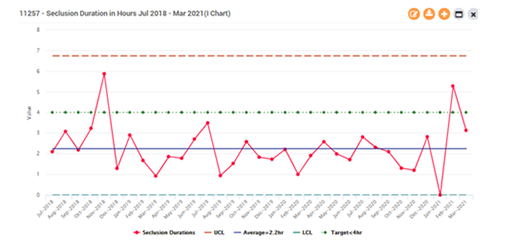Sustain and spread
Once the change has been implemented and there is measurable improvement, the final step of the project is about sustaining and spreading the improvement.
How do you sustain the improvements made?
The sustainability phase is about maintaining the improvements achieved by the project and embedding your Seclusion Reduction changes into standard practice.
To achieve this, you need to develop a sustainability plan to ensure the improvements made are not lost. Rather than waiting until the end, it is worthwhile you think about sustainability during the early stages of the improvement project.
- The NHS Sustainability model will assist you in considering the sustainability of the improvement.
Considerations to integrate improvement into everyday work practice include:
- Standardisation (work processes, roles and responsibilities, documentation)
- Incorporating education and training into existing training for all staff
- Ongoing data collection and evaluation to monitor and refine process.
Data collection of your project measures should be part of ongoing monitoring and embedded into standard practice, by your ward or health service. This forms part of the sustainability plan.
The continued collection of data can be done less frequently and with less data that was done during the testing process. For example, if your project was about increasing completion rates on "Safety Plan" and you successfully implemented a change, you may have initially collected risk assessment data for ten consumers on a weekly basis and monitored the sustainability for two months.
Then you may have decided to drop down to collecting 5 points of data fortnightly, then monthly, three-monthly, six-monthly etc. Periodic measurement is appropriate unless the issues associated with high risk or has been key performance indicators (KPI) in your local health district service agreement with NSW Health.
For example, Seclusion Duration (in hours) is one of the KPIs aiming to reduce or eliminate of seclusions in Mental Health Services. The chart below demonstrates a stable process for this hospital in seclusion durations.

You can also include staff and patient stories and other feedback as part of the ongoing monitoring. Importantly, this data needs to be visible to your project sponsor, health service executive or senior management.
If at any point the improvement is not maintained, the project team can intervene and may resume more frequent measurement to better understand why compliance has reduced. This is where you may need to repeat your PDSA cycles.
How do you spread the improvement?
Spreading is about actively disseminating the improvement across the heath service or district/network by implementing the changes in other wards/units.
For example, if you successfully implemented changes to increase completion rates on "care plan" in a general Mental Health Inpatient Unit, you would likely need to take a different approach in a Mental Health ICU/HDU, which may have a completely different workflow.
What works in one setting, may not work in another so it is worth revisiting the improvement process to make any modifications to suit the nuances of your next targeted ward/unit (for example, culture, processes).
- The IHI's Seven Spreadly Sins provides practical tips on how to successfully spread an improvement.
The future and beyond
Once an improvement project is completed and the improvement has been sustained and spread, it is the responsibility of the health service to continually monitor the ongoing success.
The ever-shifting health care environment and the evolving technologies mean that established processes can be impacted.
For example, your local safety plan may change moving from a paper to an electronic environment
It is recommended that measures are built into the health service's performance indicators and audits are completed regularly (as determined by the health service).
